There is always more to explore in any technique.
My blog is a living document, I often add new swatches to previous posts, but sometimes choose as here, to add a new post to a growing collection of information on specific topics.
I shared two previous posts on working with elastic: 1, and 2. Many of the same design repeats may be hand knit or using a G carriage to produce pleated knit and purl knits.
A sample of a pattern similar to the block ones executed below, knit on the machine using hand transfers between beds. 
 Changing yarns sometimes even simply using a different dye lot, tensions, or elastic manufacturer brands or colors can alter the appearance of the results significantly.
Changing yarns sometimes even simply using a different dye lot, tensions, or elastic manufacturer brands or colors can alter the appearance of the results significantly.
A previous post shared that the traditional yarn positions for the thick and thin yarns in the feeders need to be reversed when using the elastic for 3D effects. At times as I return to previous posts I find that explanations or reasons for the recommended directions are missing, especially if the steps appeared to be obvious at that moment in time.
I recently initially assessed the need for the position swap in thread lace using elastic as an “oddity” on my machine. It took a Ravelry response to remind me of the float formation in this fabric.
In review: the “lace holes” are formed by knitting a fine thread with a significantly thicker yarn as the “second color”. When the fine yarn knits, a larger stitch in it alone is formed on the knit face of the fabric, with the thicker yarn floating behind it. The thicker yarn goes in Brother’s A feeder, the thinner in B. The resulting effect, shown in a previous post  An ancient elastic sample and the corresponding punchcard using elastic as the “thin” yarn.
An ancient elastic sample and the corresponding punchcard using elastic as the “thin” yarn.  Using the traditional yarn positions: both yarns would knit on needles that are not selected, corresponding to the unpunched squares in the card. The thin yarn alone would knit on needles corresponding to the punched holes, with the thick yarn floating behind it. To create the punched shapes as puckers with the elastic floating behind them, if the yarn positions are switched in the feeders, both yarns still knit together where there are no punched holes (or pixels), and the thin yarn (elastic) will float behind the shapes in the other fiber, creating the resulting 3D textures.
Using the traditional yarn positions: both yarns would knit on needles that are not selected, corresponding to the unpunched squares in the card. The thin yarn alone would knit on needles corresponding to the punched holes, with the thick yarn floating behind it. To create the punched shapes as puckers with the elastic floating behind them, if the yarn positions are switched in the feeders, both yarns still knit together where there are no punched holes (or pixels), and the thin yarn (elastic) will float behind the shapes in the other fiber, creating the resulting 3D textures.
My present elastic stash includes a small supply of 2 colors of recently purchased elastic and a purple cone of equal weight from my teaching days (UKI, no longer manufactured).
Another UK source for 2 thicknesses sold in varied size cones https://airedaleyarns.co.uk/index.php/yarns-fibres-for/knitting-machine/boomerang-2ply-3ply-lycra-yarn.html also lists international shipping rates https://airedaleyarns.co.uk/index.php/postage.html.
The blue yarn in these beginning tests is a 2/20 wool, the elastic a combination of the purple and blue threaded together in the tension unit.
When elastic is old, it loses the ability to spring back when used in knits though when tugged on manually it may appear to have a good recovery response to stretching. The result can be seen on the purl side of the swatches. When on the machine both threads appeared to be feeding evenly and smoothly with no contrast, while when off the machine, the purple does not recover and its floats are loose and droopy compared to the blue.
End needle selection is canceled. If for some reason end needles come out to the patterning position, they should be pushed back manually. The amount of weight used, if any, depends on the yarn and tension but also on the knitter’s preference.
The fabric shrinks considerably in width when off the machine. Any plain knitting above or below the rows worked in the pattern will ruffle, making end-use suitable in bands for that purpose.
These first tests explore evenly distributed black/white pixels planned first for a 50X24 repeat, A, with borders of white pixels on each side where both yarns will knit together. ![]() A shorter repeat, B, with smaller blocks, 51X16
A shorter repeat, B, with smaller blocks, 51X16 ![]() The charted repeats are shown in a single width, repeated twice in height, and are also suitable for punchcard machines.
The charted repeats are shown in a single width, repeated twice in height, and are also suitable for punchcard machines.  On the machine: when using the thread lace setting for these fabrics, generally the pattern is programmed so that the floats on the back of the fabric are created by the elastic yarns being used, intended to gather the results for the 3D texture on the knit side. The tool here is inserted beneath the elastic floats, the wrong yarn selection is shown below it, with the wool rather than the elastic forming the floats, the result if using standard yarn positions.
On the machine: when using the thread lace setting for these fabrics, generally the pattern is programmed so that the floats on the back of the fabric are created by the elastic yarns being used, intended to gather the results for the 3D texture on the knit side. The tool here is inserted beneath the elastic floats, the wrong yarn selection is shown below it, with the wool rather than the elastic forming the floats, the result if using standard yarn positions.
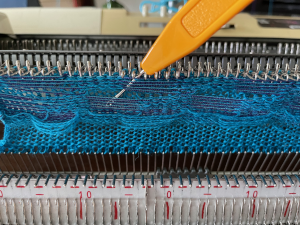 In patterns where positive and negative design spaces are equal, this is less of a factor.
In patterns where positive and negative design spaces are equal, this is less of a factor.
Comparing results: A  B:
B:  Notice the purple elastic droop. The fabric is similar to some of my racked samples such as this one, but it is knit single bed, far quicker and easier to produce, but the floats on the purl side are merit consideration when planning end-use.
Notice the purple elastic droop. The fabric is similar to some of my racked samples such as this one, but it is knit single bed, far quicker and easier to produce, but the floats on the purl side are merit consideration when planning end-use.  These zig-zag variations are equal in height but with balanced numbers of black and white pixels in each row, a single repeat of 12 stitches in width is charted on the left, for 8 stitches in width on the right, making them usable in punchcard machines as well. The fabric produced does not create crisp and immediately identifiable shapes on the knit side.
These zig-zag variations are equal in height but with balanced numbers of black and white pixels in each row, a single repeat of 12 stitches in width is charted on the left, for 8 stitches in width on the right, making them usable in punchcard machines as well. The fabric produced does not create crisp and immediately identifiable shapes on the knit side. 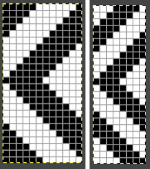 A 60X24 repeat including a 2 stitch border using the 12X24 repeat, one of the elastic strands was not feeding as evenly as the other
A 60X24 repeat including a 2 stitch border using the 12X24 repeat, one of the elastic strands was not feeding as evenly as the other ![]()
![]()
 A 60X24 repeat including a 2 stitch border using the 8X24 repeat
A 60X24 repeat including a 2 stitch border using the 8X24 repeat ![]()
![]()

When working with larger repeats the floats for the elastic get proportionately wider. A 18X22 pixel repeat ![]() Color is reversed, so white pixels will knit both yarns together, and black pixels will pull on the white areas thus creating the 3D effect
Color is reversed, so white pixels will knit both yarns together, and black pixels will pull on the white areas thus creating the 3D effect 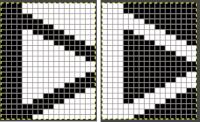 planned for knitting on a test on 58 stitches, with both yarns knitting a border on each side,
planned for knitting on a test on 58 stitches, with both yarns knitting a border on each side, ![]()

Combining shapes of different sizes, and mirroring them ![]()

![]() The sample was knit on 75 stitches, off the machine, and relaxed it measured 5.25 inches in width, with pinning and the effort to stretch it, it reached an 8.5-inch width. A single strand of the elastic was not enough to obtain the desired effect, it was used double strand again in this final swatch.
The sample was knit on 75 stitches, off the machine, and relaxed it measured 5.25 inches in width, with pinning and the effort to stretch it, it reached an 8.5-inch width. A single strand of the elastic was not enough to obtain the desired effect, it was used double strand again in this final swatch.
The knit on the machine: the elastic is pulled tight across the fixed width between the needles, droops slightly as knitting progresses and it relaxes. 
 How it might begin to appear when stretched on the body or a form.
How it might begin to appear when stretched on the body or a form. 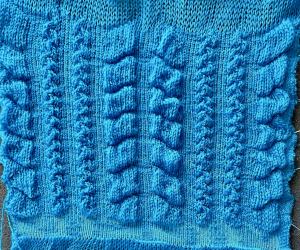
Some fair isle variations knit using one fiber that felts, the other that does not, achieve similar effects, but with far more recognizable shapes.
Here a leaf pattern is knit with UKI 3M elastic using the thread lace setting as in the above swatches. 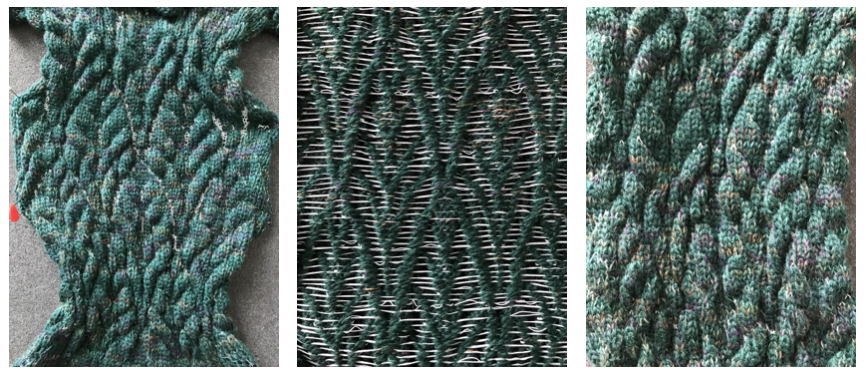 The same repeat now knit using the fair isle setting, exchanging yarn positions with wool forming the long floats on the left, rayon chainette on the right, and followed by felting.
The same repeat now knit using the fair isle setting, exchanging yarn positions with wool forming the long floats on the left, rayon chainette on the right, and followed by felting. 